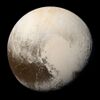Astronomy:(229762) 2007 UK126
 (229762) 2007 UK126 and its satellite, imaged by the Hubble Space Telescope on 2 January 2018. | |
| Discovery[1] | |
|---|---|
| Discovered by | M. E. Schwamb M. E. Brown D. L. Rabinowitz |
| Discovery date | 19 October 2007 |
| Designations | |
| (229762) 2007 UK126 | |
| Minor planet category | Scat-ext[2][3] |
| Orbital characteristics[6] | |
| Epoch 23 March 2018 (JD 2458200.5) | |
| Uncertainty parameter 2 | |
| Observation arc | 12,629 days (34.58 yr) |
| Earliest precovery date | 16 August 1982 |
| |{{{apsis}}}|helion}} | 108.2806 astronomical unit|AU (16.19855 Tm) |
| |{{{apsis}}}|helion}} | 37.4740 AU (5.60603 Tm) |
| 72.8773 AU (10.90229 Tm) | |
| Eccentricity | 0.48579 |
| Orbital period | 622.15 yr (227,241 d) |
| Mean anomaly | 343.6090° |
| Mean motion | 0° 0m 5.703s / day |
| Inclination | 23.3648° |
| Longitude of ascending node | 131.1567° |
| 346.9215° | |
| Known satellites | 1[4][5] |
| Physical characteristics | |
| Dimensions | 599–629 km[7] 648+60 −46 km[8] 599±77 km[5] 612 km[9] |
| Mean density | <1.74 g/cm3[8] |
| Rotation period | >8 h, presumably 11.05 h[10] |
| Geometric albedo | 0.15±0.016[7] 0.167+0.058 −0.038[5] |
| Physics | 50–55 K max.[7] |
| Apparent magnitude | 20.8[1] |
| Absolute magnitude (H) | 3.69±0.10[5] 3.5[6] |
(229762) 2007 UK126, also written as (229762) 2007 UK126, is a scattered disc object (SDO) with a bright absolute magnitude of 3.7.[5] This makes it probably a dwarf planet. (As of June 2018), Mike Brown lists it as highly likely a dwarf planet.[11] Its light-curve amplitude is estimated to be Δm = 0.03 ± 0.01 mag.[10]
Its orbital eccentricity of 0.49 suggests that it was gravitationally scattered onto its eccentric orbit. It will come to perihelion in July 2046.[6]
It has been observed 171 times over 15 oppositions with precovery images back to 1982.[6]
Satellite
It has been reported that (229762) 2007 UK126 has a satellite, but a mass estimate has not been made.[5] The magnitude difference between the primary and the satellite is 3.79 mag. The satellite has a tentative diameter of 103 km, a semi-major axis of 3600±1300 km, and an estimated orbital period of 5.9 d.[4]
See also
References
- ↑ 1.0 1.1 "2007 UK126". Minor Planet Electronic Circular: D38. 2008. Bibcode: 2008MPEC....D...38S.
- ↑ Marc W. Buie (2012-05-08). "Orbit Fit and Astrometric record for 229762". SwRI (Space Science Department). http://www.boulder.swri.edu/~buie/kbo/astrom/229762.html. Retrieved 2012-05-07.
- ↑ "List Of Centaurs and Scattered-Disk Objects". Minor Planet Center. http://www.minorplanetcenter.org/iau/lists/Centaurs.html. Retrieved 2012-05-07.
- ↑ 4.0 4.1 (229762) 2007 UK126, Johnston's Archive. Last updated 20 September 2014
- ↑ 5.0 5.1 5.2 5.3 5.4 5.5 Santos-Sanz, P.; Lellouch, E.; Fornasier, S.; Kiss, C.; Pal, A.; Müller, T. G.; Vilenius, E.; Stansberry, J. et al. (2012). ""TNOs are Cool": A survey of the trans-Neptunian region IV. Size/albedo characterization of 15 scattered disk and detached objects observed with Herschel-PACS". Astronomy & Astrophysics 541: A92. doi:10.1051/0004-6361/201118541. Bibcode: 2012A&A...541A..92S.
- ↑ 6.0 6.1 6.2 6.3 "JPL Small-Body Database Browser: 229762 (2007 UK126)". http://ssd.jpl.nasa.gov/sbdb.cgi?sstr=229762. Retrieved 19 July 2018.
- ↑ 7.0 7.1 7.2 Schindler, K.; Wolf, J.; Bardecker, J.; Olsen, A.; Müller, T.; Kiss, C.; Ortiz, J. L.; Braga-Ribas, F. et al. (2017). "Results from a triple chord stellar occultation and far-infrared photometry of the trans-Neptunian object (229762) 2007 UK126" (in en). Astronomy & Astrophysics 600: A12. doi:10.1051/0004-6361/201628620. Bibcode: 2017A&A...600A..12S. https://doi.org/10.1051/0004-6361/201628620.
- ↑ 8.0 8.1 Results from the 2014 November 15th multi-chord stellar occultation by the TNO (229762) 2007 UK126, 2016.
- ↑ Michael E. Brown. "How many dwarf planets are there in the outer solar system? (updates daily)"
- ↑ 10.0 10.1 Thirouin, A.; Noll, K. S.; Ortiz, J. L.; Morales, N. (2014-09-01). "Rotational properties of the binary and non-binary populations in the trans-Neptunian belt" (in en). Astronomy & Astrophysics 569: A3. doi:10.1051/0004-6361/201423567. Bibcode: 2014A&A...569A...3T. https://doi.org/10.1051/0004-6361/201423567.
- ↑ Michael E. Brown (June 12, 2018). "How many dwarf planets are there in the outer solar system? (updates daily)". California Institute of Technology. Archived from the original on 2018-06-15. https://web.archive.org/web/20180615191556/http://web.gps.caltech.edu/~mbrown/dps.html. Retrieved 2018-07-19.
External links
- 2007 UK126 Precovery Images
- 3rd largest scattered disk object discovered (Yahoo Groups)
- 2007 UK126 Minor planet designation number
- (229762) 2007 UK126 at the JPL Small-Body Database



